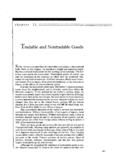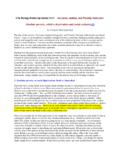Transcription of CHILD LABOR: A REVIEW* - gdsnet.org
1 The World Bank December 1994 CHILD LABOR: A REVIEW* by Christiaan Grootaert and Ravi Kanbur Contents: 1. Introduction 2. The Nature and Magnitude of CHILD Labor 3. The Determinants of CHILD Labor 4. The Welfare Economics of CHILD Labor 5. Policy Intervention 6. Conclusion * Background paper for the 1995 World Development Report, on Labor. The authors would like to thank Michael Walton and the 1995 WDR Team for useful feedback on an earlier version of the paper, and Susan Cochrane for sharing her many insights into the links between fertility, education and CHILD labor. Any views expressed in this paper are those of the authors only and should not be attributed to the World Bank or its affiliated organizations. 1. Introduction - 2 - CHILD labor is upsetting. The popular images in the developed world are drawn from Dickens and the dark, satanic mills of the industrial revolution on the one hand, and the sweatshops and street children of the cities of the developing world on the other.
2 A common, and natural enough, reaction in developing countries has been legislation to ban CHILD labor, following the historical lead of the developed world as it emerged from its period of industrialization. In fact, trade sanctions are being recommended in some developed countries, against the exports of developing countries that use CHILD labor. Many, including developing country governments, see this as a thinly disguised protectionist device. Many others, economists among them, have argued that CHILD labor legislation, even if it could be enforced, is not the only way, or necessarily the best way, of tackling the issue. Against this background, this paper presents on overview of the recent literature on CHILD labor. Section 2 considers the problems of defining CHILD labor - conceptual and empirical, and discusses some recent estimates of the magnitude of the problem. Section 3 moves to a discussion of the determinants of CHILD labor, focussing first on supply and then on demand.
3 Section 4 sets out the welfare economics framework within which policy interventions can be analyzed. In light of this, Section 5 assesses a range of policy interventions, including legislation. Section 6 concludes. The basic message of this paper is that there seems to us to be an emerging consensus in the literature. The policy response to CHILD labor will have to vary depending upon which types of CHILD labor and CHILD labor arrangements are prevalent, and depending upon the institutional and administrative capacity of the country in question. While CHILD labor legislation is an important component of the policy package, this by itself is neither necessary nor sufficient for making a rapid and significant dent in the problem. It will have to be accompanied by a range of incentives, for schooling, for example, and a range of targeted interventions. This, together with equitable economic growth, is what will eventually reduce CHILD labor to levels that can be addressed by legislation.
4 2. The Nature and Magnitude of CHILD Labor How much CHILD labor is there in the world The answer to this question depends, of course, on what one means by CHILD labor. At one extreme, all non-educational, non-leisure time of - 3 - individuals below a certain age can be counted as CHILD labor. At the other extreme, only full-time employment in economic activity would be counted. The former includes light work after school or in school holidays, which helps in skill acquisition, while the latter excludes part-time engagement in such horrendous activities as CHILD prostitution. Part of the definitional problem arises because when most people talk of CHILD labor they mean bad CHILD labor such as prostitution, or scavenging, or backbreaking work on a construction site, or long hours in a carpet factory, etc. Such bad CHILD labor can be part-time or full-time, and a CHILD can both engage in schooling and in bad CHILD labor.
5 Getting comparable estimates for such CHILD labor is impossible, not least because what constitutes bad CHILD labor is itself in dispute. The term CHILD labor covers a wide range of situations, to which the ethical, economic and legal response could be very different (see Box 1: Four CHILD workers). To begin with, it is not clear how to define CHILD . In the West, it is customary to do so by chronological age, but in many societies cultural and social factors enter as well (Rodgers and Standing, 1981). The evolution of a CHILD to adulthood passes through socially and biologically defined life phases, over which the degree of dependence and the need for protection of the CHILD gradually declines, , in many societies an apprentice even if only eight or nine years old is often not considered a CHILD - a determination based on social status rather than age (Morice, 1981). In that sense too, many societies, especially poor rural ones, do not view CHILD work as bad.
6 Rather, it is part of the socialization process which gradually introduces the CHILD into work activities and teaches the CHILD survival skills. This view is present in many African countries (Bekombo, 1981; Agiobu-Kemmer, 1992). - 4 - Box 1. Four CHILD workers Deepa, school girl in rural Maharashtra Deepa is ten years old and attends primary school . She is lucky because many girls at her age must stay home to take care of their younger siblings. Yet, every day after school , she must help her father on the farm, together with her two older brothers. After they finish the farm work they return home to do their homework and to study. Deepa and her brothers are among millions of school children in India, and the developing world at large, who combine going to school with work at the household farm or other enterprise. The work probably harms their study effort to some degree, but their work is also essential to make it possible for the household to afford the children's schooling.
7 CHILD labor legislation usually exempts this type of home production activities from regulation. Ade, street trader in Lagos Ade is in the last class of primary school , and like more than one third of his class mates he hawks goods on the streets after school hours. Like most of the children, he started trading on the street before his ninth birthday. Some children have fixed spots on street corners, fuel stations or entrances of large buildings, others peddle their wares from place to place along the streets, and others go from door to door in residential areas. The work is not without risk. The children are exposed to air pollution, vehicle accidents, abduction and sexual exploitation and assault. Most street hawkers originate from lower socio-economic status homes, and their parents rarely received more than primary education. While a majority of their fathers have wage employment, most mothers are traders too.
8 Street trading by children is a profitable business: many children replenish the stock of merchandise they carry several times during a selling period, and manage to sell more than an adult trader. Their income is hence a significant contribution to household income. For most children their earnings also go towards purchase of school books and other supplies. And while street trading children tend to perform poor academically, they often excel in various social and leadership qualities. Juan, quarry worker in Bogot Most of the quarries in Bogot operate without a permit from the city authorities. They use low technology extraction methods. After large rocks have been extracted with bulldozers and explosives, they are pulverized in mechanical crushers. Workers then separate the material according to size. Children use shovels and sieves in this task. Juan, at age 13, is among the older children workers in the quarries. One fifth of them are less than 10 years old and some started at age five.
9 Two thirds of the children have worked at the quarries between one and five years. In spite of the hard work, 50 percent of them attend school , often in the evening at a community center. Surprisingly, only one third said that they disliked the work, the others saw it as learning a trade or were proud that their earnings helped support their families. Most of the children live in squatter settlements at the outskirts of Bogot . Their parents have little or no education, and most have no stable employment. They justify their children's work by saying that leisure leads to crime and by pointing at the high unemployment in Colombia, even among well-educated adults. Taeng, masseuse in Bangkok Taeng left her native village in N. Thailand when she was 17 to come to Bangkok. Most girls who go South are 17-18, or sometimes younger, with only a few years of primary education. Often they have an older sister, or aunt, who already works at the coffee shop.
10 Sometimes an agent, who lent their parents money to build a house, arranges the placement of the girls. They often come from the least-endowed villages where there are few opportunities for local employment outside agriculture, and where there is a long agricultural off-season. If they're lucky, the girls wind up working in an upscale parlor, which provides them with accommodation and regular medical checks. But if a bond is involved, the agent locks up the girls and they have no personal freedom. Most girls see themselves as family breadwinners - they do not like what they do, but they know they must remit money to help pay for daily living expenses of their families, for the school fees of their brothers and sisters, to dig a well or build a house. Many return home after a number of years, to a mix of sympathy and derision from their fellow villagers. Note: These cases are authors' composite constructions based on case studies in Jejeebhoy, 1993, Oloko, 1991, Salazar, 1988, Phongpaichit, 1982, Weiner, 1991, and Myers, 1991.













